AP psychology College Board Exam
1/572
There's no tags or description
Looks like no tags are added yet.
Name | Mastery | Learn | Test | Matching | Spaced |
|---|
No study sessions yet.
573 Terms
Nature (Heredity / Genes):
Refers to the biological traits passed down from your parents.
It influences things like:
Physical characteristics (eye color, height),
Temperament and personality tendencies
Intelligence levels
mental health risk (like depression or schizophrenia)
Nurture (Environment)
Represents the experiences and surroundings that shape development.
Includes:
Parenting style
Education quality
Culture and social norms
Life events (e.g., trauma, travel, friendship)
Interaction between Nature and Nurture
Some may inherit a genetic risk for anxiety, but whether that trait develops can be influenced by the environment (like a stressful household Vs. a calm, supportive one)
Key Concept: Nature provides the range of possibilities. Nurture influences where someone ends up within that range.
Natural selection
Traits that offer an advantage in survival and reproduction are more likely to be passed on.
Fear responses
Are explained as the body’s automatic reactions to perceived threats, often involving a ‘fight or flight’ response.
This involves physiological changes like increased heart rate and adrenaline release, along with behavior responses like attacking the threat of fleeing.
How of Fear perceived
Fear is triggered when we perceived a stimulus as dangerous or threatening, even if it’s not objectively dangerous.
Fight or Flight Response
The classic “fight or flight” response is a core feature of fear, involving the body preparing for either confronting or escaping the threat.
Physiological changes during fear
This response involves the release of hormones like adrenaline, increasing heart rate, blood pressure, and respiration, preparing the body for physical action.
Behavior reactions during fear
Fear can lead to aggressive behavior, such as attacking the threat, or it can lead to escape, such as fleeing the situation.
Learning Fear
Fear can be learned through condition, where a neutral stimulus becomes associated with a frightening experiences, leading to fear of that stimulus.
Fear responses
A strong innate fear of potentially dangerous stimuli like snakes or spiders is thought to have evolved as a survival mechanism. Seeing these creates quickly triggers a fight-or-flight response, allowing ancestors to avoid dangerous encounters.
Social bonding behaviors
Caring for children is a crucial social bonding behavior that ensures the survival of offspring. Evolutionary psychologists suggest that this behavior is driven by biological and evolutionary pressures, promoting parental investment and attachment.
Mate preferences
Humans have evolved specific preferences for certain physical and behavioral traits in potential mates. These preferences, such as youth and attractiveness in females or strength and resources in males, are thought to reflect evolutionary adaptations aimed at selecting partners who will contribute to the survival and propagation of offspring.
Aggression and competition
Aggression and competition can serve various evolutionary purposes, including securing resources, defending territory, and competing for mates. While these behaviors can have negative consequences in modern society, they are thought to have been adaptive in ancestral environments.
Eugenics
It is a set of beliefs and practices to improve the human species by selectively breeding people with desirable hereditary traits. Though it has been used historically as justifican for some of the cruellest acts against humanity, including involuntary sterilisation and the racial hygiene programmes that culminated the Holocaust.
Social Darwinism
Wrongfully applying “survival of the fittest” to justify inequality.
Twin studies
Is one way how we study to see how much behavior comes from genes vs. environments.
Twins Studies is used in comparisons, where identical twins (100% shared genes) and fraternal twins (around 50% shared genes) are compared.
If identical twins are more alike in a trait than fraternal twins, that suggests a genetic influence.
Family studies
Is one way how we study to see how much behavior comes from genes vs. environments.
Family studies track traits or disorder across family members.
And the more genetically related two people are, the more likely they are to share a certain trait.
Adoption studies
Is one way how we study to see how much behavior comes from genes vs. environments.
And adoption studies are where adopted children are compared to their biological parents, to test genetic influence, and compared to their adoptive parents, to test environmental influence.
Especially helpful for studying traits like intelligence, temperament, and personality.
Nervous system
Your nervous systems is the control and communication system of your body. Everything —- from breaking, moving your limbs, or thinking through stats homework—- runs through this network.
THe main divisions are the central nervous systems and the peripheral nervous system.
These two systems constantly communicate to keep you functioning, both consciously and unconsciously.
Central Nervous system
The CNS is made up of the brain and the spinal cord. It’s responsible for processing all incoming info and deciding how the body should respond.
Major roles:
-Processing sensory input (like sound sight and touch)
-Makes decision and send back instruction
-Control movements and behavior
-Home of higher level functions: Memory, Emotion, Throughout, learning, Consciousness.
In short: the CNS is the boss —- it process, decides, and send commands.
Peripheral Nervous system
The PNS links the CNS to the rest of the body. Basically, its made of all the nerves outside the brain and spinal cord.
Main jobs:
-Delivers messages from body to brain (and back)
-Collects sensory inform from environment
-Carries out motor instructions to muscles and organs
The PNS breads down into two key parts; the somatic and autonomic systems which do very different things.
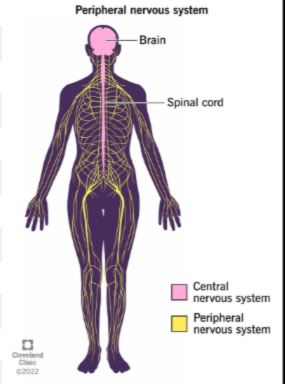
Somatic Nervous system
The SNS, which is a part of the Peripheral nervous systems, handles voluntary stuff —- anything you can consciously control, like flexing your hand or walking to class.
Functions include:
-Moving skeletal muscles
-Process sensory input (so reacting to stimulus like touch, pain, temperature)
-Letting you act intentionally in your environment
Think: SNS = “Stuff you control”
Autonomic Nervous system
The SNS, which is a part of the Peripheral nervous systems, handles all the automatic body process — things happening without you thinking about it.
Involuntary functions:
-Breathing (when unconscious)
-Heart rate
-Digestion
-Pupil dilation
-Body temperature control
The ANS has two opposing subsystems that help the body response to changes: The sympathetic nervous system and the parasympathetic nervous system.
Sympathetic nervous system (fight-or-flight)
Is one of the two opposing subsystems of the Autonomic nervous system and it is categorized as the Fight-or-Flight systems.
-It activities in stressful/emergency situations
-It boosts heart rate, dilates pupils, and slows digestion.
-it Prepares your body for action.
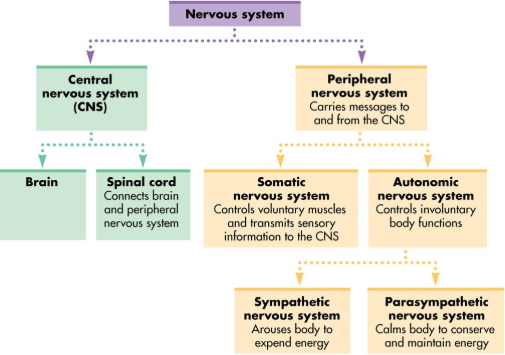
Parasympathetic Nervous system
Is one of the two opposing subsystems of the Autonomic nervous system and it is categorized as the Rest-and-Digest
-it brings the body back to calm after stress
-Slows heart rate, and stimulate digestion
-Restore balance and conserves energy
How all the parts of the nervous system work together:
How all the part of the nervous system work together:
You touch a hot stove —— the somatic system send pain signals to CNS
CNS process it and send command to move your hand
The autonomic system might kick in too — heart rate increases your sweat a little
Once safe, the parasympathetic system calms things back down.
Neurons
It is a nerve cell, the basic unit of the nervous system, and it is responsible for receiving, processing, and transmitting information.
It is the main player in information transmission as it sends electrical and chemical signals.
It forms complex pathways that allow everything from reflect to abstract thinking.
Glial Cells
Are supporting cells in the nervous system that protect and support neurons. They don't transmit nerve impulses like neurons do, but they help nervous function efficiently.
They Support Neurons by:
Structuring the nervous system
Creating insulation (myelin sheath)
Helping with communication and waste cleanup together neurons + glial cells = the foundation of all behavior and mental process
Myelin sheath
Gila Cells produce myelin, which is an insulating sheath that speed up nerve impulses.

Reflex arc
Sometimes, your body reacts before your brain even realizes what happened. That thanks to the reflect arc
Reflex arc = fast, automatic response that skips the brain for speed.
How a reflex arc happens:
Sensory Neuron: Senses the input (e.g., burning your finger)
Interneuron: process Info in the spinal cord
Motor Neuron: tells your body to move (pull hand away)
Senonsry Neuron
Is a nerve cell that carries information from your senses (like sight touch, taste, smell, and hearing) to your brain and spinal cord. These neurons acts as messengers for the nervous system, bring information about the outside world and your body's internal state to the central nervous system for processing.
Interneuron
Is a neuron that acts as a connector within the central nervous system, connecting sensory and motor neurons. They are in the central nervous system and they help with processing information, integrating signals, and coordinating complex behaviors.
Within the CNS, interneurons act as intermediaries. They process and integrate sensory information. Depending on the situation, they may send the information to higher brain regions for conscious processing or reflexidy to send it to motor neurons.
Motor Neuron
Is a nerve cell that carries signals away from the brain and spinal cord to muscles and glands, causing them to move or react. Essentially they’re the message that tell your body what to do, by controlling voluntary and involuntary movements.
They are found in both the CNS and the Peripheral Nervous system.
Neural Transmission
Is how Neurons communicate:
Resting Potential: Neuron is ready, with a slightly negative charge inside
Threshold: The level of stimulation needed to trigger firing
Action Potential: The electrical charge fires— follows the All or Nothing Principle (it fires fully or not at all)
Depolarization: Positive ions flood in, flipping the charge
Refractory Period: Neuron resets, can’t fire until it returns to resting potential
Reuptake: Extra neurotransmitters are taken back into the sending neuron
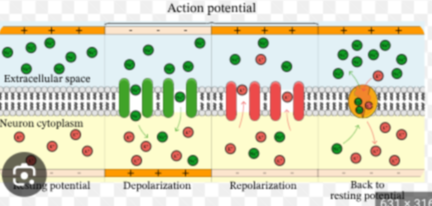
Multiple Sclerosis
It is one of the disruptions to neural transmission, how neurons communicate with each other, where there is damage to myelin sheath around the neurons which slows/clogs the signals.
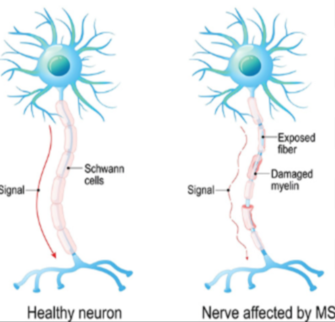
Myasthenia Gravis
It is one of the disruption to neural transmission and it is a neuromuscular disorder where the body’s immune system mistakenly attacks the communication between nerves and muscles, leading to muscle weakness and fatigue.
Dopamine
It is a neurotransmitter that can act as both an inhibitory and excitatory neurotransmitter and it governs reward, motivation, and motor control.
Too much will cause Schizophrenia and too little will cause Parkinson’s disease.
Neurotransmitters
Is a chemical messenger that facilitates communication between neurons, enabling them to transmit signals across a synapse.
They can be excitatory, meaning they increase the likelihood of the receiving neuron firing, or inhibitory, meaning they decrease the likelihood of firing.
Serotonin
Is a neurotransmitter that can act both inhibitory and excitatory and it regulates mood, sleep, and appetite.
And low levels of this are linked to depression.
Norepinephrine
is an excitatory neurotransmitter and it increases alertness and arousal and it is a stress response. It plays a big role in the fight or flight response.
GABA
Is a inhibitory (slows things down) neurotransmitter and it’s low levels causes things like anxiety and seizures.
Glutamate
Is the most common excitatory neurotransmitter and it involves memory. And too much of this causes migraines and seizures.
Acetylcholine
It is an excitatory neurotransmitter and it controls muscle movement and is important for learning and memory.
It is also linked to Alzheimer’s.
Endorphins
Is an inhibitory neurotransmitter that relieves pain and give pleasure and it is natural opioid (drugs that alter pain precpetion, reduce anxiety, and produce a sense of euphoria)
Substance P
Is a excitatory neurotransmitter and it sends pain signals through the spinal cord to the brain.
Parkinson’s disease
Is a progressive neurodegenerative disorder the affect movement by slowing it down, causing muscle stiffness and balance problems.
It occurs when nerve cells in the brain that produce dopamine are damaged or die. This leads to a decline in dopamine levels resulting in this.
Alzheimer’s
Is a progressive brain disorders that mainly affects memory, thinking, and eventually, the ability to perform basic daily tasks.
Hormones
Are chemical messengers produced by glands in the body that travel through the bloodstream to influence various behaviors and processes.
They act like signal what can affect mood, motivation, and other mental states, similar to how neurotransmitter impacts behavior, but over a longer duration and broader reach.
Adrenaline (epinephrine)
It is a hormone that induces the fight-or flight response.
Leptin
Is a Hormone that when released tell you when you’re full.
Ghrelin
Is a hormone that when is released it triggers hunger.
Melatonin
Is a Hormone that regulate sleep cycles.
And this hormone is produced by the pineal gland, and it regulates sleep by acting as a time cue for the body’s biological clock and promoting sleep anticipation.
Oxytocin
Is a hormones that influence bonding, trust, love and humans connection
It influences social bonding, particularly between mothers and infants, and is involved in prosocial behavior like helping and trust. It also helps regulate the stress response, contributing to feelings of safety and well-being.
Agonists
It is a type of psychoactive drug that interferes with normal neurotransmitter activity by mimic neurotransmitters by binding to the receptors that are made for the neurotransmitters that it is mimicking.
This increases the production of that neurotransmitter or blocks the reuptake because it occupies the reuptake transporter. Which overall makes them more available.
So these substances mimic the neurotransmitter to enhance the effect of the original neurotransmitter.
For example some anti-anxiety medication that cases an increase in brain neurotransmitters called GABA which helps decrease neural activity and calm people down.
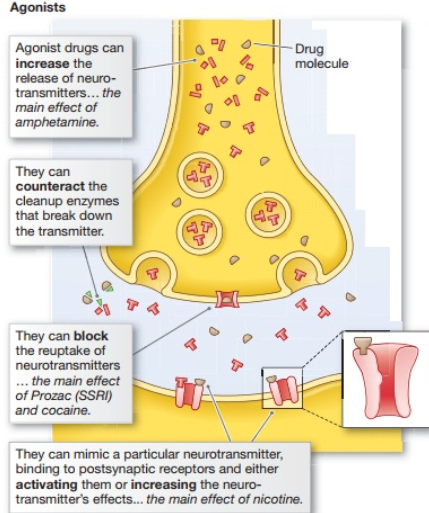
Antagonists
It is a type of psychoactive drug that interferes with normal neurotransmitter activity by blocking neurotransmitters from binding to receptors.
These drugs decrease the effectiveness of neurotransmission. They do this by blocking the neurotransmitter from being released from the presynaptic axon terminal. Or by connecting to the postsynaptic receptor and blocking the intended neurotransmitter from binding there.
This reduces the effects from the neurotransmitter that is being blocked or prevents any effect at all.
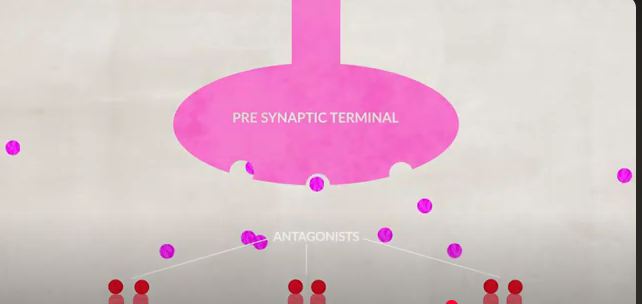
Reuptake inhibitors
It is a type of psychoactive drug that interferes with normal neurotransmitter activity by preventing neurotransmitters from being reabsorbed, which increased their effect.
So they block the neurotransmitters from being absorbed back into the presynaptic axon terminal. This impacts the neurotransmitters because it impacts the reuptake process for NT present in the synaptic cleft which controls how long the signal from the neurotransmitter will last.
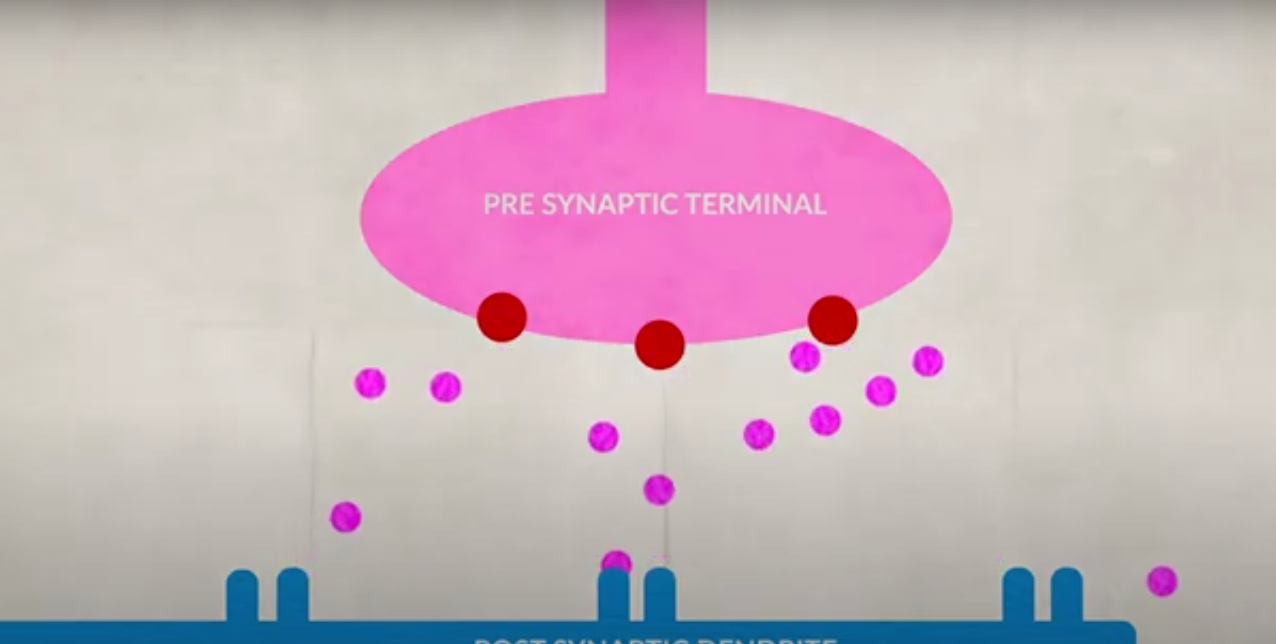
inhibitory neurotransmitters
The release of inhibitory neurotransmitters generally cause a slowing or damping of brain functions and behaviors. They do this by prevent or reducing the firing of nerve cells, ultimately decreasing neuronal excitability and thus slowing down various process in the brain.
For example when dopamine acts as a inhibitory neurotransmitter, while dopamine is associated with pleasure and motivation it’s not directly causing pleasure by slowing down brain functions. Instead, its inhibitory actions, are crucial for regulating dopamine release and mating normal dopamine levels.
The pleasure associated with dopamine is more about ti role in reinforcing behaviors and creating the ‘wanting’ or ‘seeking’ drive, not necessarily a slowing down of brain functions.
excitatory neurotransmitters
Are neurotransmitters that generally increase brain functions by facilitating communication between nerve cells. They increase the likelihood of a neuron firing and action potentials, which is essential for various brain activities, including learning, memory, and cognitive functions.
Stimulants
Psychoactive drugs that are classified as drugs that speed up messages travelling between the brain and body. They have the effect of increase heart rate, alertness, energy, and euphoria.
Examples: Caffeine, nicotine, cocaine, and amphetamines.
Depressants
Psychoactive drugs that are classified as drugs that slow down the activity of the central nervous system. They have the effect of relaxation, slowed processing, reduced coordination and memory.
Examples: alcohol, benzodiazepines
Hallucinogens
Are a class of psychoactive drugs that induce profound alterations in perception, cognition, and consciousness. They have the effect of sensory distribution, hallucinations, altered thinking/ memory.
Examples; Marijuana (THC), LSD, psilocybin.
Opioids
Psychoactive drugs that are classified as drugs that interact with specific brain receptors to reduce pain and produce feeling of euphoria, which causes a high addiction risk.
Examples; heroin, morphine, OxyContin.
Stimulant drugs
Caffeine: a drug that increases activity in the brain and central nervous systems, leading to increase alertness, elevated mood, and a postponement of fatigue.
Nicotine: Is a drug that affects the central nervous system and causes mood-altering effects like a sense of well-being and relaxation. It also increases heart rate and oxygen use by the heart. And it is highly addictive due to its ability to trigger the release of dopamine in the brain reward centers.
Cocaine: a powerful stimulant drug that increases levels of dopamine, a neurotransmitter associated with pleasure and movement, in the brain's reward circuit
Amphetamines: a group of synthetic psychoactive drugs that stimulate the central nervous system, increasing heart rate, blood pressure, energy levels, alertness while decreasing appetite
Depressant drugs
Alcohol: this drug affect your central nervous system, by slowing down brain activity and communication between the brain and body. It increases the amount of neurotransmitter GABA in the brain, which as a calming and sedative effect. Leading to slower reflexes, impacted coordination, and drowsiness.
Benzodiazepines: this drug slows down brain activity by enhancing the effects of GABA. Which leading to sedative, anti-anxiety, and muscle-relaxing properties. They are commonly prescribed for anxiety, panic disorder, and insomnia.
Hallucinogens drugs
Marijuana (THC): Is a drug that contains the compound of cannabinoids, such as THC (tetrahydrocannabinol), which can produce various effects on the mind and body when consumed. THC works in the brain by bind to cannabinoid receptors, resulting in euphoria, relaxation, alters perception, and other effects.
LSD: Is a drug that affects the nervous system by interacting with serotonin receptors that play a role in perception and cognition. It has the effect of alter perception, thoughts, and emotions, sometimes leading to vivid hallucinations. It can also trigger anxiety, paranoia, and even presistin visual distraction called “flashbacks.”
Psilocybin: Is naturally occurring specifically found in mushrooms. It later perception, mood, and through process, leading to vivid visual and auditory hallucinations, a disorder sense of time, and potentially perceived spiritual experiences.
Opioids drugs
Heroine: is drug that produces intense euphoria and pain relief by rapidly crossing the blood-brain barrier and binding to opioid receptors. This leads to increased dopamine release in the brain’s reward pathways, contributing to its addictive potential.
Morphine: Is a drug that binds to mu receptors, which inhibits pain signals and increasing dopamine release, which results in pain relief and feelings of pleasure. And it is commonly presence for ever pain relief.
OxyContin: is a drug that binds to mu receptors, leading to pain relief and euphoria. It also increases dopamine levels, reinforcing its use and potential for addiction.
All these opioids increase dopamine release in the brains rewards system, which is response for feelings of pleasure and reinforce of drug-seeking behavior.
They inhibit GABA neurons which normally suppress dopamine release.
Tolerance
One way long-term drug use changes the brain and behavior overtime is it causes individuals to need more of a drug to get the same effects.
This develops as the brain and body adapt to the presence of the drug. This process is known as neuroadaptation, where the brain’s Chemistry changes in response to repeated drug use.
Addiction
One way long-term drug use changes the brain and behavior overtime is it causes a drug user to compulsively seed the drug, despite harm.
Withdrawal
One way long-term drug use changes the brain and behavior overtime is when you stop the drug use the brain reacts due to the established tolerance.
Physical symptoms (sweating, nausea).
Emotional/mental symptoms (anxiety, cravings)
Forebrain
Is a part of the Cerebrum
The ________ consists of the thalamus, hypothalamus, amygdala, and the hippocampus.
The hypothalamus, amygdala, and hippocampus make up what we call the limbic system of your brain.
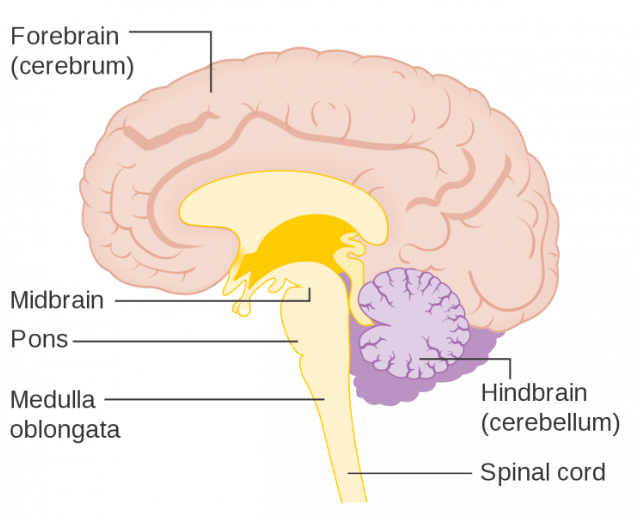
Thalamus
This area is one of the parts of the forebrain.
The _______ is located between the cerebral cortex and the midbrain.
It is made up of nuclei that receive different sensory and motor inputs (information related to movement and coordination). The ______ then relays these signals to various areas of the cerebral cortex.
The ______ also regulates consciousness, sleep, and wakefulness, feeding and satisfaction and alertness.
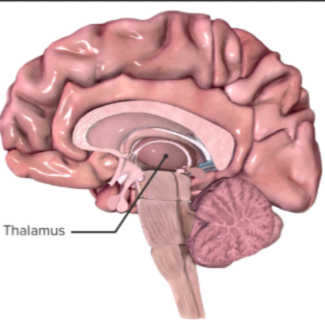
Limbic system
The _____ _______ is a group of brain structures that regulate basic emotions such as fear and rage and drives such as hunger and sex.
The brain structures that make up the limbic system are somewhat controversial; however, the general consensus of the limbic system contains these three main structures; the hippocampus, the amygdala, and the hypothalamus.

Hippocampus
This brain area is a part forebrain (cerebrum) and the limbic system.
The _________ is vital for long-term memory formation, particularly declarative memories, or memories that can be purposely recalled like facts and events.
Loss of the function to the ___________ results in the inability to form new memories.
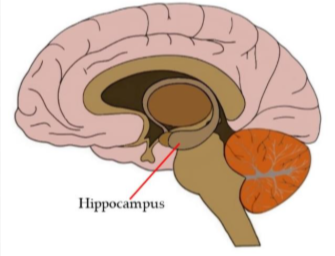
Hypothalamus
This brain area is a part forebrain (cerebrum) and the limbic system.
Similar to the Thalamus, the ________ is made up of multiple nuclei with many different functions.
The ________ regulates the autonomic nervous system by producing and releasing hormones.
Through its influence on the endocrine system (network of glands that produce and release hormones, which act as chemical messengers to regulate various bodily function), it can regulate sleep-wake cycles, respiration, and other autonomic responses.

Amygdala
This brain area is a part forebrain (cerebrum) and the limbic system.
The________ is the center of emotion and motivations.
The ________ is responsible for fear responses and learning out of fearful situations.
The _________ is also involved in regulations of memory consolidation or the process of turning a memory into long-term memory.
The amygdala has also been linked to sexual and aggressive behavior and anxiety.

Midbrain
The ______ is part of the brainstem and it is made up of several smaller structures.
It supports multiple functions including:
Vision
Hearing
Motor control (especially eye movement)
Sleeping
Waking
alertness
temperature regulation
With the reticular formation also being located in the midbrain.
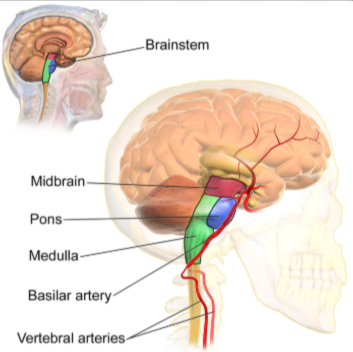
Reticular formation
It is in the midbrain (which is located in the brain stem) and is a network of nerve cells within the brainstem that plays a key role in regulating:
Consciousness
arousal
and the sleep-wake cycle
It acts as a “gatekeeper” for sensory information, helping to filter and prioritize stimuli that reach the cerebral cortex.
Damage can result in sleep disorders or even coma.

Hindbrain
The _______ is the most primitive (basic) part of the brain. It regulates all of our most vital processes with three structures:
The medulla, pons, and cerebellum
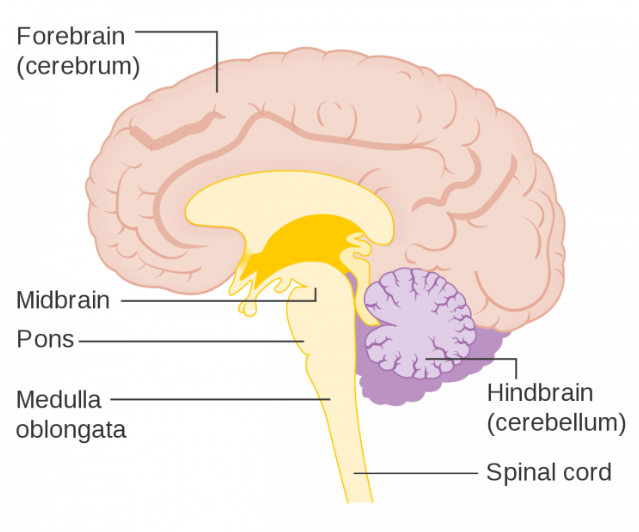
Medulla
Is a structure in the hindbrain and the brainstem, and it controls automatic (involuntary) functions of the body, such as:
Breathing
Heart rate
blood pressure

Pons
Is a structure in the hindbrain and the brainstem. It regulates several functions including:
Hearing
Equilibrium (body balance, as it helps relay sensory information, including that from the vestibular system in the inner ear, which is crucial for balance)
Taste
Facial sensations
movements
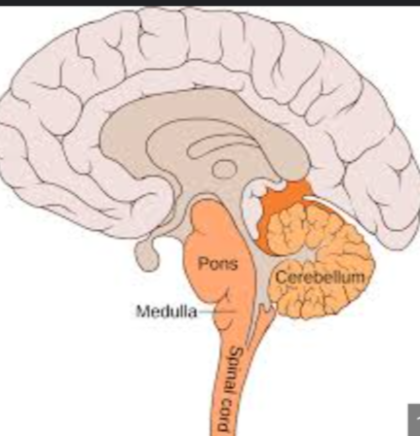
Cerebellum
Is a structure in the hindbrain and it plays a role in motor control and movement including:
balance
subtle movement
equilibrium.
It also plays a role in cognitive functions such as attention and language.
It is primarily involved in procedural memory, which is a type of unconscious or unintentional memory that involves skills and habits.

Brainstem
is the most basic, vital part of the brain, located at the back and base of the brain, connecting to the spinal cord. It contains the midbrain, pons, medulla, and reticular formation.
It’s responsible for automatic life-sustain functions like breathing, heart rate, blood pressure, and it also plays a role in sensory information process and motor control.
Essentially, it’s the “old brain” that keeps us alive and funding at a basic level.
This and the cerebellum make up the hindbrain.

Cerebrum
The ______ is the largest part of the brain. It is made up of two cerebral hemispheres (the left and right hemispheres) that are separated by a large groove called the medial longitudinal fissure.
The hemisphere are mirror images of each other, with somes exceptions (Broca’s area, Wernicke’s area).
The hemisphere can share information with each other through a thick bundle of nerves running between them called the corpus callosum.
Each hemisphere is made up of the cerebral cortex, or the outer layer of tissue of the hemisphere, and smaller subcortical structures.
These subcortical structures include the thalamus, hypothalamus, basal ganglia, hippocampus, amygdala, internal capsule, and corpus callosum.
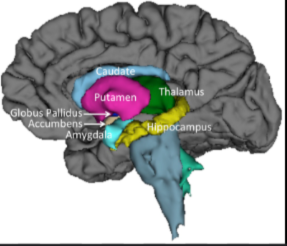
Cerebral cortex
Is the outermost layer of the cerebrum, responsive for complex thinking, problem-solving, and conscious awareness.
As we grow and learn, the neurons in our cerebral cortex grow and are connected with other neurons.
The cerebral cortex is made up of four lobes: Parientla, Occipital, Temporal, and Frontal.
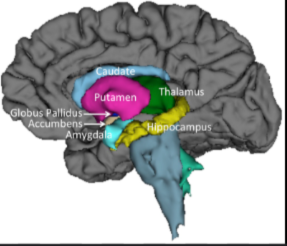
Left hemisphere
Is one of the hemisphere of the cerebrum and it is connected to the other hemisphere by the corpus callosum
It usually handles language and logic, analysis..
Right hemisphere
Is one of the hemisphere of the cerebrum and it is connected to the other hemisphere by the corpus callosum.
It usually handles spatial awareness (the ability to understand the location of objects and your own body in space, including their relationships to each other), emotion, and holistic processing (the way our brains perceive and recognize faces by integrating all features together as a whole, rather than individually).
Basil ganglia
is located deep in the Cerebrum, and is not a part of the forebrain, and it is a group of nuclei that function as a unit.
It plays a role in the goal-direct control of voluntary movements (like picking up a piece of fruit with your hand) and routine behaviors.
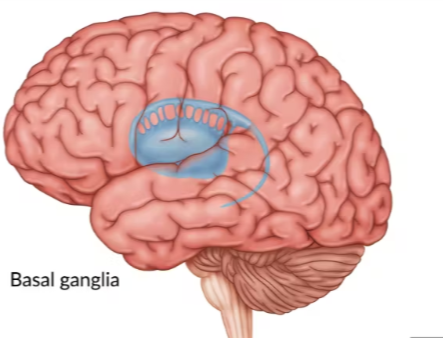
Olfactory bulbs
Is located in the cerebrum, and it is not a part of the forebrain, and they are structure involved in processing smell information.
The act as relay station, receiving signals from the olfactory nerve in the nose and then transmitting them to other brain areas like the amygdala and hippocampus, crucial for emotions, memories, and learning.
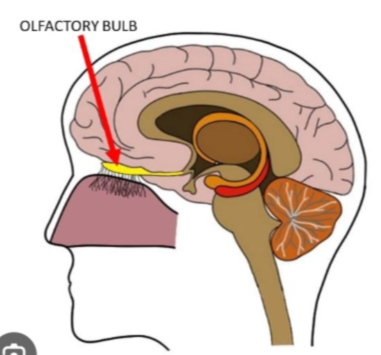
How do we smell and process smell
How do we smell and process smell:
Olfactory Receptor Cells: These specialized nerve cells, located in the nose, detect odor molecules
Olfactory nerve: When an odorant molecule binds to an olfactory receptor, it triggers an electrical signal that travels along the olfactory nerve.
Olfactory bulb: the Olfactory bulb receives these signals from the olfactory nerve
Transduction: The olfactory bulb acts as a bridge, converting electric signals from the olfactory nerve into a form that the brain can process.
Relating to other Brain Areas: from the olfactory bulb, the processed smell information is then sent to the amygdala, hippocampus, and other parts of the brain.
Emotional and Memory Association: The Olfactory bulb’s connection to the amygdala and hippocampus explains why smells can evoke strong emotions and trigger memories.
Parietal lobe
is one of the lobes in the cerebral cortex and it is located at the top of the brain, between the frontal and Occipital lobe.
It consists of the somatosensory cortex and is responsible for integrating sensory information from different parts of the body, especially visual information related to navigation and spatial orientation.
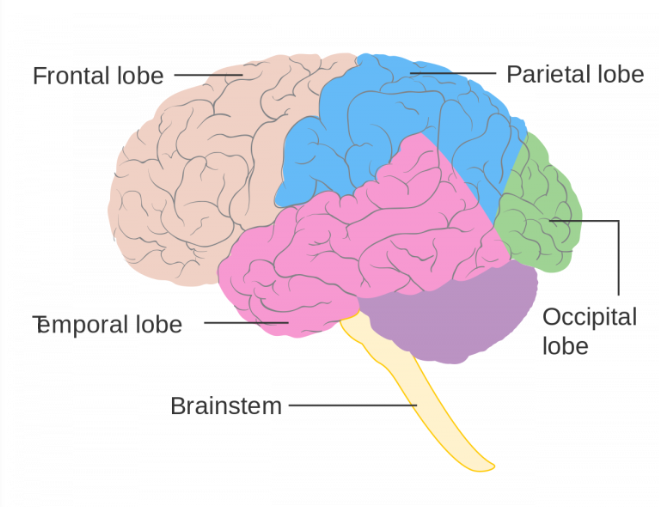
Somatosensory cortex
Is the cortex in the parietal lobe and it is located right behind the primary motor cortex.
The main function of the ___________ cortex is to process sensory information from the boy, including touch, temperature, pain, and the position of body parts.
It’s like the brain’s sensory map, helping use feel things and understand where our body is in space.
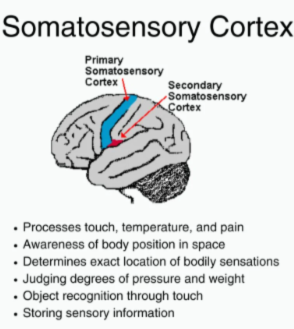
Occipital lobe
Is the lobe that is located in the back of the cerebral cortex. It is home to the primary visual cortex and the central area for visual processing, visual perception, and color recognition.

Temporal lobe
Is a area of the cerebral cortex and is located on the sides of the brain, just behind the temple and ears.
It's primary function is processing auditory sensory input and is the location of the primary auditory cortex and Wernicke’s area.
However, it also plays a role in interpreting meaning from visual stimuli and object recognition.

Primary auditory cortex
is an area located only in the left temporal lobe, and it is important for understanding semantics (the meaning and interpretation of words, speech, symbols, and sentence structures within the context of communication and understanding) in speech and vision.
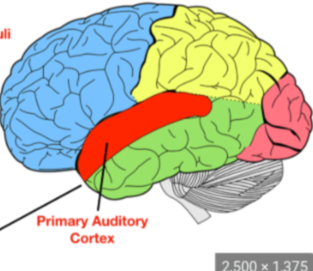
Wernicke’s area
Is located in the back of the temporal lobe near the occipital lobe of the left cerebral hemisphere and is involved in understanding written and spoken language.
Damage to this area results in the person being able to speak using proper Grammar, syntax, and intonation, but the words they use will not make any sense.

Frontal lobe
is a area of the cerebral cortex and it is located at the front portion of the cerebrum and is home to many important brain structure included the primary motor cortex, prefrontal cortex, and Broca’s area.
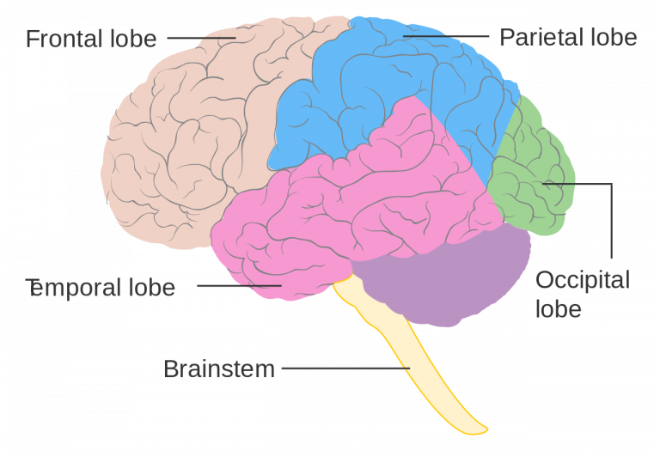
Primary motor cortex
is an area in the temporal lobe and it regulates voluntary movements such as walking. The right hemisphere of the this controls the left side of the body and the left hemisphere of this controls the right side of the body. With different areas of the cortex control different areas of the body.

Prefrontal cortex
is an area in the frontal lobe and it is located at the very front of the frontal lobe, and it controls executive functions, or a set of higher-level cognitive processes that allow us to manage our thoughts, actions, and behaviors.
These behaviors include:
attention
inhibition
working memory
problem-solving
planning
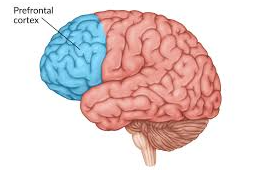
Broca’s area
Is an area located in the left hemisphere in the frontal lobe.
This area is responsible for speech production and language comprehension.
Damage to this area can result in Broca’s aphasia. This is a condition in which you know what you want to say, but when you say it, it does not make sense.
